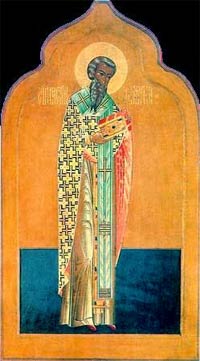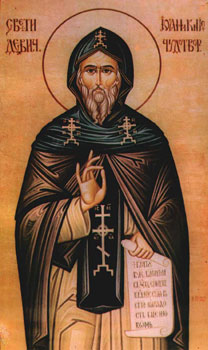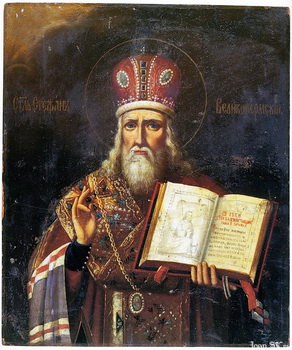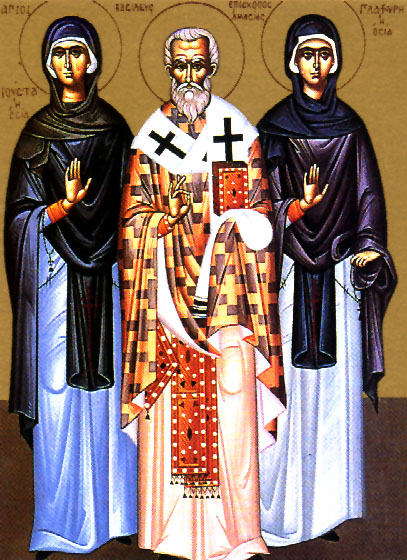|
|
The Hieromartyr Basil, Bishop of Amasea Licinius, the brother-in-law of the Emperor Constantine, whose sister he had married, dissembled before the great Emperor, saying that he was a Christian. When he received authority over the whole of the East, he began, at first secretly but then publicly, to persecute the Christians and to uphold idolatry. His wife grieved greatly over this, but could not turn her husband back from this dishonour. Giving himself over to idolatry, Licinius gave himself over to all the passions, and especially to brutality towards women. Through this fall into such an impure passion, he desired to deflower the maiden Glaphyra, who was in waiting at the imperial court. She complained to the Empress, who sent her away from the court at Nicomedia secretly to the coast of Pontus. The maiden got as far as the town of Amasea, and was there warmly received by the bishop, Basil, and the other Christians. Glaphyra was very joyful that God had preserved her virginity, and wrote of this to the Empress. And the Empress rejoiced and sent her money for the Church in Amasea. But one letter of Glaphyra's, on its way to the Empress, fell into the hands of an imperial eunuch, who showed it to Emperor Licinius. Discovering where Glaphyra was to be found, he immediately sent orders that she and the bishop be brought to Nicomedia. In the meantime, Glaphyra died, and the soldiers brought only Basil, in bonds. After torture and imprisonment, this blessed man was beheaded and thrown into the sea, in the year 322. His priests, with the help of an angel of God, found his body near the town of Synope, took it out of the water with the aid of fishing nets and carried it to Amasea, where they gave it burial in the church which he had built by his labours. The Emperor Constantine raised an army against Licinius, overcame him, arrested him and sent him into exile in Gaul, where he ended his God-hating days. Licinius, the brother-in-law of the Emperor Constantine, whose sister he had married, dissembled before the great Emperor, saying that he was a Christian. When he received authority over the whole of the East, he began, at first secretly but then publicly, to persecute the Christians and to uphold idolatry. His wife grieved greatly over this, but could not turn her husband back from this dishonour. Giving himself over to idolatry, Licinius gave himself over to all the passions, and especially to brutality towards women. Through this fall into such an impure passion, he desired to deflower the maiden Glaphyra, who was in waiting at the imperial court. She complained to the Empress, who sent her away from the court at Nicomedia secretly to the coast of Pontus. The maiden got as far as the town of Amasea, and was there warmly received by the bishop, Basil, and the other Christians. Glaphyra was very joyful that God had preserved her virginity, and wrote of this to the Empress. And the Empress rejoiced and sent her money for the Church in Amasea. But one letter of Glaphyra's, on its way to the Empress, fell into the hands of an imperial eunuch, who showed it to Emperor Licinius. Discovering where Glaphyra was to be found, he immediately sent orders that she and the bishop be brought to Nicomedia. In the meantime, Glaphyra died, and the soldiers brought only Basil, in bonds. After torture and imprisonment, this blessed man was beheaded and thrown into the sea, in the year 322. His priests, with the help of an angel of God, found his body near the town of Synope, took it out of the water with the aid of fishing nets and carried it to Amasea, where they gave it burial in the church which he had built by his labours. The Emperor Constantine raised an army against Licinius, overcame him, arrested him and sent him into exile in Gaul, where he ended his God-hating days. St Janik of Devic He was a Serb from Zeta. As a young man, overcome with love for Christ, he left his home and went off to the region of the Ibar, to the mouth of he Black River, to a narrow cave in which, according to tradition, St Peter of Korisa had lived in asceticism before him. But when his fame began to spread among the people, he fled to Drnica and hid himself in the thick forest of Devic. St Janik spent years there in solitude, silence and prayer. According to tradition, the Serbian Prince George Brankovic brought his mad daughter to him, and the saint healed her. In gratitude, George built a monastery in that place known today by the name of Devic. Here are kept Janik's holy and wonderworking relics. In this monastery there lived almost to the present day a famous and godly nun, Euphemia, better-known in the Kossovo region as Blessed Stojna. She entered into rest in the Lord in 1895. He was a Serb from Zeta. As a young man, overcome with love for Christ, he left his home and went off to the region of the Ibar, to the mouth of he Black River, to a narrow cave in which, according to tradition, St Peter of Korisa had lived in asceticism before him. But when his fame began to spread among the people, he fled to Drnica and hid himself in the thick forest of Devic. St Janik spent years there in solitude, silence and prayer. According to tradition, the Serbian Prince George Brankovic brought his mad daughter to him, and the saint healed her. In gratitude, George built a monastery in that place known today by the name of Devic. Here are kept Janik's holy and wonderworking relics. In this monastery there lived almost to the present day a famous and godly nun, Euphemia, better-known in the Kossovo region as Blessed Stojna. She entered into rest in the Lord in 1895. St Stephen of Perm A Russian by birth, he gave himself from his youth to prayer and pondering on God, and as a young man went to Rostov, where he became a monk in the monastery of St Gregory the Theologian. Learning about the land of Perm, all overgrown with the weeds of paganism, Stephen conceived the desire to be a missionary in that land. He immediately set about learning the language and, when he had become proficient, compiled an alphabet and translated the service books. With the blessing of the Metropolitan of Moscow, he, as a priest, set off on his apostolic labours and began with apostolic zeal to preach the Gospel in the thick darkness of Permian paganism. Baptising a number of souls, he laboured to build in Perm a church dedicated to the Annunciation. And, when the Church in Perm grew larger, he was consecrated as its bishop. Enduring all toil, pain, evil and humiliation, he succeeded in dispersing the darkness among the pagan Permians and in illumining them with the light of Christ. He returned once in old age to Moscow, and there went to the Lord in 1396. A Russian by birth, he gave himself from his youth to prayer and pondering on God, and as a young man went to Rostov, where he became a monk in the monastery of St Gregory the Theologian. Learning about the land of Perm, all overgrown with the weeds of paganism, Stephen conceived the desire to be a missionary in that land. He immediately set about learning the language and, when he had become proficient, compiled an alphabet and translated the service books. With the blessing of the Metropolitan of Moscow, he, as a priest, set off on his apostolic labours and began with apostolic zeal to preach the Gospel in the thick darkness of Permian paganism. Baptising a number of souls, he laboured to build in Perm a church dedicated to the Annunciation. And, when the Church in Perm grew larger, he was consecrated as its bishop. Enduring all toil, pain, evil and humiliation, he succeeded in dispersing the darkness among the pagan Permians and in illumining them with the light of Christ. He returned once in old age to Moscow, and there went to the Lord in 1396. Righteous Virgin Glaphyra of Nicomedia (322) The Virgin Glaphyra. Licinius burned with passion for Glaphyra, a maidservant of his wife Constantia.The holy virgin reported this to the empress and sought her help. Dressing her in men’s attire and providing her with money, the empress Constantia sent her to Pontus in the company of a devoted servant. They told the emperor that Glaphyra had gone mad and lay near death. On her way to Armenia, St Glaphyra stopped in Amasea, where the local bishop, St Basil, gave her shelter... The Virgin Glaphyra. Licinius burned with passion for Glaphyra, a maidservant of his wife Constantia.The holy virgin reported this to the empress and sought her help. Dressing her in men’s attire and providing her with money, the empress Constantia sent her to Pontus in the company of a devoted servant. They told the emperor that Glaphyra had gone mad and lay near death. On her way to Armenia, St Glaphyra stopped in Amasea, where the local bishop, St Basil, gave her shelter...Venerable Jusca, righteous
St. Nestor the Silent
|